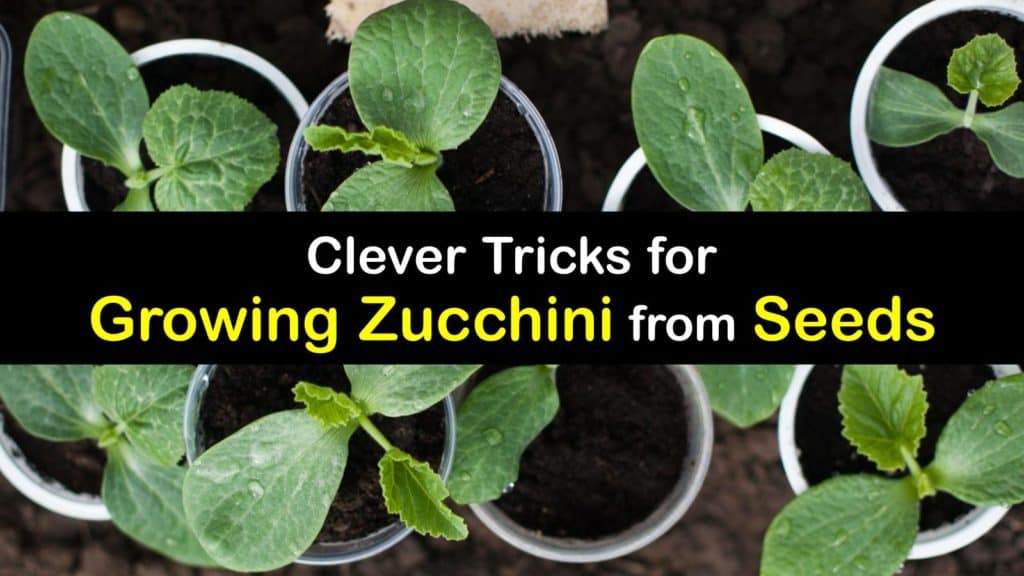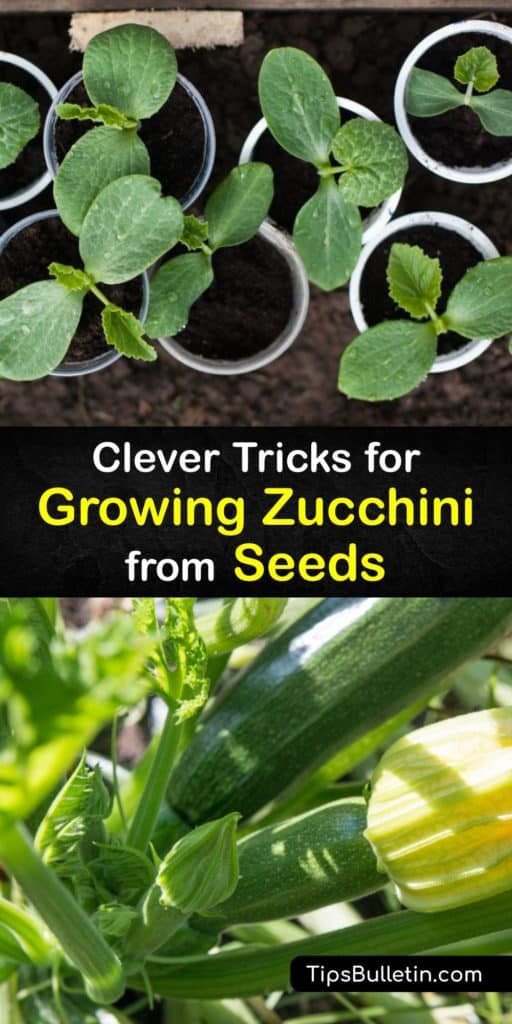Growing zucchini from seeds is easy, satisfying, and rewards your efforts with an abundant harvest of delicious squash all summer long. Just a few zucchini plants yield enough to feed a small village, and you’ll have plenty to share with your neighbors. Read on to discover the best gardening tips for how to grow zucchini from seed and keep it flourishing in your garden throughout the growing season.
Zucchini, or Cucurbita pepo by its botanical name, is one of many cultivars of summer squash. These warm-season crops produce fruit through the summer, and the squash is harvested before it’s fully mature. In contrast, winter squash stays on the vine until autumn once they reach full maturity. Zucchini plants take 45-55 days to start bearing fruit.
In warm climates, plant seeds directly in your garden bed after the last danger of frost has passed. Many growers in colder regions prefer to get a head start by sowing seeds indoors in early spring.

Easy Tips for Growing Zucchini from Seeds
If you’re wondering how to plant zucchini seeds or you grow butternut squash from seeds, know that it’s pretty straightforward. Like most other fruiting plants, zucchini requires full sun – six or more hours of direct sunlight each day.
Plant zucchini in an area with well-draining soil rich in organic matter. Zucchini plants require consistent levels of soil moisture, but be careful to avoid overwatering.
In most cases, zucchini plants need about an inch of water per week. Give them extra during periods of hot or dry weather. Use a thick mulch layer to retain moisture, insulate the soil, and minimize weed growth.
Zucchini plants are heavy feeders and benefit from regular doses of organic zucchini plant fertilizer. Use an all-purpose fertilizer that has equal amounts of nitrogen (N), phosphorus (P), and potassium (K).
Apply it according to the instructions listed on the product label every four to six weeks throughout the growing season. You can also add some Epsom salt for zucchini plants to increase plant health and get larger fruit.

Pollination is crucial for getting a plentiful zucchini harvest. The female flowers only stay open for one day, so the window of opportunity is relatively short.
Companion planting for zucchini with aromatic herbs and flowers to attract pollinators is helpful so you don’t have to hand-pollinate your zucchini flowers using a paintbrush.
Female flowers have a small node at their base, which is the immature fruit. If it remains unfertilized, the node shrivels and turns yellow. Male flowers have a stamen full of pollen in their centers.
There are vining and bush varieties of zucchini available. Bush varieties are easier to harvest because all the fruit develops around the center of the plant.
Growing cucumbers and zucchini on a trellis works well for these vining types of plants. Here are a few of the top zucchini squash varieties for home gardeners.
How to Plant Zucchini Seeds
When considering how to plant zucchini seeds, there are a few critical factors to keep in mind, including how deep to plant zucchini seeds, soil temperature, and plant spacing.
Sow zucchini seeds one inch deep in moist soil that you amend with organic compost or all-purpose fertilizer.
Cover them lightly with soil, and protect your planting area with a cold frame in frost-prone climates. The optimal soil temperature to germinate zucchini seeds is 70-85 degrees Fahrenheit.
Germination typically takes seven to ten days. To speed things up, soak the seeds in water for 24 hours before planting to break down their protective outer coating and improve germination rates.
Spacing between mature plants should be about two feet for bush varieties and more for vining cultivars. Check the seed packet for variety-specific recommendations. Most gardeners prefer planting zucchini in raised mounds of soil, which provides warmer soil and better drainage.
If you start seed indoors, ensure that your seedlings get enough light by placing them in a sunny, south-facing window. If you don’t have a sunny windowsill available, consider using a grow light to prevent your seedlings from becoming elongated or “leggy.”
When to Plant Zucchini Seeds
When to plant zucchini seeds depends on your USDA growing zone. For direct seeding, sow seeds one or two weeks after your average last frost date or whenever the soil is consistently warmer than 65 degrees Fahrenheit.
For planting zucchini seeds indoors, start them two to four weeks before the last spring frost. Wait until the danger of frost has passed before transplanting your seedlings.
How to Grow Zucchini from Seed in Containers
If there is no space for a garden plot or raised bed, don’t worry. A few of the more compact zucchini cultivars like Bush Baby are perfect for container gardening. Plant seeds using the same methods.
For the best results, the way to grow zucchini in a pot is to use a container at least 12 inches deep and 24 inches wide. Your pot must have drain holes at the bottom to prevent rot and fungal diseases.
Choose a nutrient-rich and well-draining potting mix and keep the soil moist but not oversaturated. Place your container close to a wall so the zucchini plant benefits from the radiant heat.
Harvesting and Storing Zucchini Squash
Since zucchini is such a prolific grower, stay on top of harvesting. During peak season, zucchini plants often produce several new fruits each day. Squash blossoms are also edible and very tasty when eaten fresh as a colorful salad garnish or stuffed and fried.
Use a sterile, sharp knife when harvesting your zucchini to avoid damaging the main stem. For prime flavor and texture, harvest zucchini as soon as they grow to a usable size.
Store fresh zucchini in the crisper drawer of your refrigerator for up to ten days. It’s best not to wash the fruit until you’re ready to use it. Is zucchini bad if its soft? Mushy zucchini is only suitable for the trash or the compost bin.
Freezing is an outstanding way to preserve the copious amounts of zucchini at the end of the season. For best results, blanch zucchini in boiling water before freezing.
Troubleshooting Common Zucchini Difficulties
Although zucchini plants are ordinarily easy to grow, they sometimes suffer from pest and disease issues. Healthy plants are far less vulnerable to attacks from pathogens and insects, so providing sufficient amounts of light, nutrients, and water is the best proactive defense.
Insect attacks come from aphids, cucumber beetles, squash bugs, and squash vine borers. Cover tender young seedlings with row covers to prevent insects from laying eggs on the plants, and protect the stem’s base with a plastic or foil collar.
Spray all parts of infested plants with an organic insecticide like neem oil or insecticidal soap.
Some gardeners wait until mid-July before planting zucchini to avoid squash vine borers. These insects emerge in late June or early July and lay eggs at the base of squash plants. When larvae hatch, they burrow into the stems to feed, quickly killing the plants.
The most common plant disease that affects zucchini is powdery mildew. It thrives in warm, moist conditions and frequently spreads through water droplets.
Use drip irrigation to keep the leaves dry when watering and ensure the plants get adequate airflow. Spray affected plants with an organic copper or sulfur fungicide.
Squash plants sometimes suffer from blossom-end rot as a result of calcium deficiency. The blossom end of the zucchini develops a watery brown patch that eventually spreads upward. Prevent this problem by adding bone meal or rock phosphate to your soil before planting.
Growing zucchini from seeds doesn’t require too much effort, and the results are incredibly satisfying. All you need is plenty of sunshine, moist soil, and warm temperatures.
Within a month or two, you’ll be harvesting a bumper crop of savory and healthful zucchini squash.

If you found these gardening tips helpful, please share this article about how to grow zucchini from seed with your family and friends on Facebook and Pinterest who may be wondering how to plant zucchini seeds.